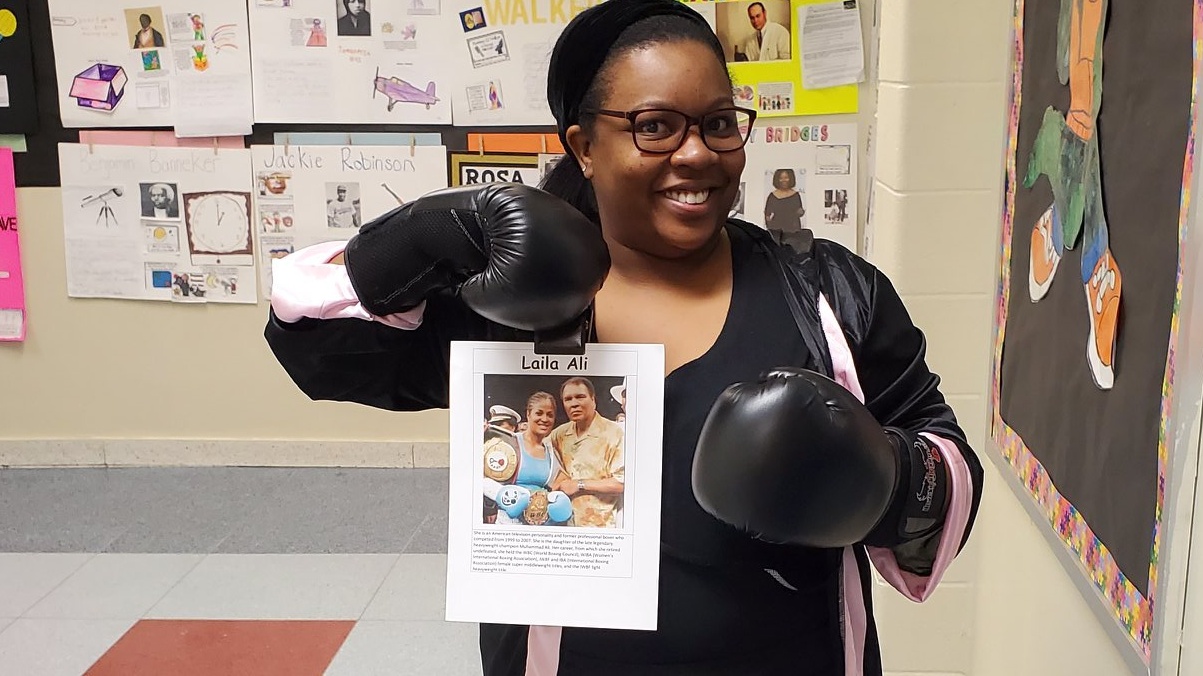Throughout Black History Month, a first-grade teacher in Suffolk, Virginia, has been dressing up as iconic Black figures.
"I decided to dress up for Black History Month so that the kids are actually seeing a live person from history," Latoya McGriff told Good Morning America. "I just wanted to bring history alive for the kids."
The Creekside Elementary School teacher has been documenting her project on Facebook since February 3 when she dressed up as Mary Jackson.
"I was Mary Jackson today! She was born in Hampton, VA," the teacher wrote. "She was a mathematician who worked as an aeronautical engineer whom people referred to as a human computer. She was the first African American Women Engineer that played a vital role in the development of the NASA Space Program! Tomorrow I will be…"
The teacher of 12 years especially wanted to focus on historical Black figures from Virginia. So she continued the Black history lesson on February 4, dressing up as iconic tennis superstar and Virginia native Arthur Ashe.
"He was the first African American tennis player selected to the United States Davis Cup team and the only African American man to ever win the singles title at Wimbledon, the US Open, and the Australian Open," the teacher wrote. "By the way I'm picking a lot of people from Virginia!"
On February 5, McGriff represented Mack Benn Jr., the first African American superintendent for Suffolk Public Schools.
"He provided Suffolk Public Schools with 35 years of service," she said. "There is a school in his honor in Suffolk."
The Black History Month project has also included other Virginia natives such as Colonel Fred Cherry, educator Florence Bowser, Dr. L.D. Britt, James Lafayette, Henrietta Lacks, Lt. Col. Howard Baugh and Maggie L. Walker.
McGriff said Cherry "was the first and highest ranking African American Officer among U.S. Prisoners of War during the Vietnam War." Bowser "was a dedicated educator in Suffolk, VA who taught in a one room schoolhouse for African American children."
Britt "is the first African American doctor in America to have an endowed chair in surgery at a Medical School." Lafayette "was born into slavery in New Kent County, Virginia. He won his freedom by spying for American colonists as a double agent during the Revolutionary War."
Dressing up as Lacks on February 20, McGriff said "she's from Roanoke, Virginia. Her cells are known as the HeLa cell and her cells lead to many important breakthroughs in biomedical research including the polio vaccine."
Baugh was a member of the Tuskegee Airmen, while Walker was the first woman bank president in America. McGriff also dressed up as more popular figures such as boxer Laila Ali, dancer Misty Copeland, author Booker T. Washington, jazz singer Ella Fitzgerald and judge Thurgood Marshall.
In an interview with Wavy, McGriff said she had a teacher who did a similar project.
“That’s what I remember, having a teacher come dressed as a storybook character," the teacher said. "Well, I could dress up as a different figure, an African American figure past or present so they can see themselves represented.”
Despite the effort it takes to dress up for a whole month, McGriff said it's worth it because she sees students asking her questions and wanting to know who she will be tomorrow.
"Today, they just said ‘Are you going to be Barack Obama? Are you going to be so-and-so?’ Because they want to know and kind of prepare themselves for it so they can tell me something they know about that person,” she said.
The Virginia teacher said, "It is important for the children to see that people who look like them have made contributions because it reassures them that they can, too."
"It's hard to believe in something you don't see," she added.
According to Good Morning America, the first-grade teacher also honored historically black colleges and universities and the nine historically Black Greek-letter organizations.
"[Learning about these organizations] gives children something to look up to, and they get excited about wanting to go to school and get to college," she said.
McGriff wants to see more Black history lessons implemented in schools.
"I hope that [people who see the story] will implement some type of Black History Month program in their school," she told Good Morning America. "They don't have to dress up like I did … but, I just want people to incorporate Black history so that other students of color can see themselves represented in history."
